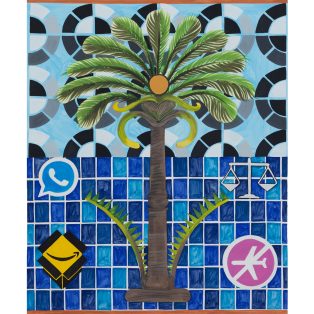Panicle Paintings is the first post-pandemic studio project by Navine G. Dossos. Fifteen symbolic paintings of palms and dates are inspired by ancient Sumerian cylinder seals: carved, ceramic tokens used to authenticate documents which often incorporated images from nature. The project began with a conversation about trees and their association with fertility in ancient Mesopotamia, a subject of common interest between the artist and one of her collectors and collaborators.
The series began as a family portrait, with allegorical paintings of Navine, her partner and their child. It subsequently evolved into a larger body of work comprising the fifteen paintings on display in this exhibition. Individual works are grouped into triptychs, creating a continuous, frieze-like work, much as the ancient cylinder seals would be rolled out onto strips of clay.
Navine has created an additional wall painting in situ: this site-specific painted frieze is related to the artist’s fascination with the reconstruction of the Ishtar Gate, excavated by archaeologists in Iraq in the early twentieth century and currently displayed (under fiercely contested circumstances) at the Pergamon Museum in Berlin.
The design and import of the trees on the cylinder seals are a fusion of archetypes: palm trees and their date panicles, or bunches or fruit, are associated with the goddess Ishtar/Inanna, representing desire and fertility; the cedar, representing masculinity and often stylised as an arrow; and a crucial hybrid typology, with merged male and female attributes in a single tree.
These painted trees are first and foremost portraits of women, mostly creative workers who are also the artist’s friends, and who, like her, experienced pregnancy and becoming a parent during the pandemic. Each tree emerged from the seals and into preparatory drawings, then developed their own personalities in relation to their subjects. In every portrait, symbols and logos from everyday life bring up different aspects of their relationships and the conditions of communication during lockdown and isolation.
This body of work marks a personal journey for Dossos in which she explores childbirth, remote and mediated relationships, fertility, and depression, with Ancient Mesopotamia, its protocols and mythologies, as visual background and reference.



